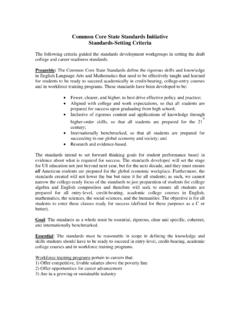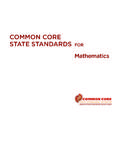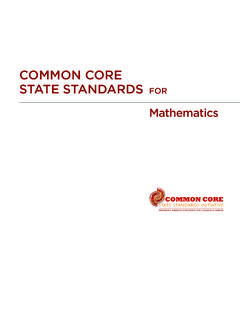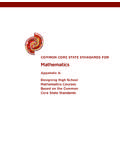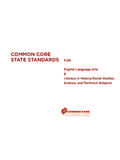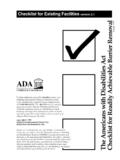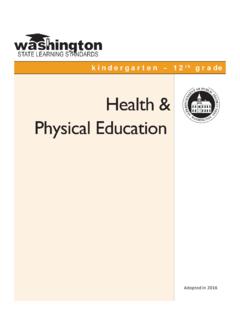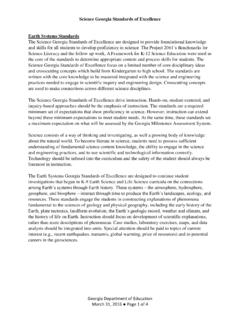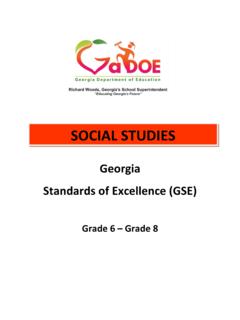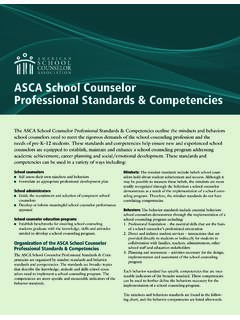Transcription of K 8 Publishers’ Criteria for the Common Core State ...
1 Page 1 SPRING 2013 RELEASE 04/09/2013 K 8 Publishers Criteria for the Common Core State standards for Mathematics These standards are not intended to be new names for old ways of doing business. They are a call to take the next step.. It is time to recognize that standards are not just promises to our children, but promises we intend to keep. CCSSM, p. 5 The Common Core State standards were developed through a bipartisan, State -led initiative spearheaded by State superintendents and State governors. The standards reflect the collective expertise of hundreds of teachers, education researchers, mathematicians, and State content experts from across the country. The standards build on the best of previous State standards plus a large body of evidence from international comparisons and domestic reports and recommendations to define a sturdy staircase to college and career readiness.
2 Most states have now adopted the standards to replace previous expectations in English language arts/literacy and mathematics. standards by themselves cannot raise achievement. standards don t stay up late at night working on lesson plans, or stay after school making sure every student learns it s teachers who do that. And standards don t implement themselves. Education leaders from the State board to the building principal must make the standards a reality in schools. Publishers too have a crucial role to play in providing the tools that teachers and students need to meet higher standards . This document, developed by the CCSSM writing team with review and collaboration from partner organizations, individual experts, and districts using the Criteria , aims to support faithful CCSSM implementation by providing Criteria for materials aligned to the Common Core State standards for Mathematics.
3 States, districts, and publishers can use these Criteria to develop, evaluate, or purchase aligned materials, or to supplement or modify existing materials to remedy weaknesses. How should alignment be judged? Traditionally, judging alignment has been approached as a crosswalking exercise. But crosswalking can result in large percentages of aligned content while obscuring the fact that the materials in question align not at all to the letter or the spirit of the standards being implemented. These Criteria are an attempt to sharpen the alignment question and make alignment and misalignment more clearly visible. These Criteria were developed from the perspective that publishers and purchasers are equally responsible for fixing the materials market.
4 Publishers cannot deliver focus to buyers who only ever complain about what has been left out, yet never complain about what has crept in. More generally, publishers cannot invest in quality if the market doesn t demand it of them nor reward them for producing it. The K 8 Publishers Criteria are structured as follows: I. Focus, Coherence, and Rigor in the Common Core State standards for Mathematics II. Criteria for Materials and Tools Aligned to the K 8 standards III. Appendix: The Structure is the standards Page 2 SPRING 2013 RELEASE 04/09/2013 I. Focus, Coherence, and Rigor in the Common Core State standards for Mathematics Less topic coverage can be associated with higher scores on those topics covered because students have more time to master the content that is taught.
5 Ginsburg et al., 2005, Reassessing International Mathematics Performance: New Findings from the 2003 TIMSS and PISA This finding that postsecondary instructors target fewer skills as being of high importance is consistent with recent policy statements and findings raising concerns that some states require too many standards to be taught and measured, rather than focusing on the most important State standards for students to attain.. Because the postsecondary survey results indicate that a more rigorous treatment of fundamental content knowledge and skills needed for credit-bearing college courses would better prepare students for postsecondary school and work, states would likely benefit from examining their State standards and, where necessary, reducing them to focus only on the knowledge and skills that research shows are essential to college and career readiness and postsecondary success.
6 ACT National Curriculum Survey 2009 Because the mathematics concepts in [ ] textbooks are often weak, the presentation becomes more mechanical than is ideal. We looked at both traditional and non-traditional textbooks used in the US and found conceptual weakness in both. Ginsburg et al., 2005, cited in CCSSM, p. 3 ..[B]ecause conventional textbook coverage is so fractured, unfocused, superficial, and unprioritized, there is no guarantee that most students will come out knowing the essential concepts of algebra. Wiggins, 20121 For years national reports have called for greater focus in mathematics education. TIMSS and other international studies have concluded that mathematics education in the United States is a mile wide and an inch deep.
7 A mile-wide inch-deep curriculum translates to less time per topic. Less time means less depth and moving on without many students. In high-performing countries, strong foundations are laid and then further knowledge is built on them; the design principle in those countries is focus with coherent progressions. The has lacked such discipline and patience. There is evidence that State standards have become somewhat more focused over the past decade. But in the absence of standards shared across states, instructional materials have not followed suit. Moreover, prior to the Common Core, State standards were making little progress in terms of coherence: states were not fueling achievement by organizing math so that the subject makes sense.
8 With the advent of the Common Core, a decade s worth of recommendations for greater focus and coherence finally have a chance to bear fruit. Focus and coherence are the two major evidence-based design principles of the Common Core State standards for These principles are meant to fuel greater achievement in a deep and rigorous curriculum, one in which students acquire 1 From 2 For some of the sources of evidence consulted during the standards development process, see pp. 91 93 of CCSSM. Page 3 SPRING 2013 RELEASE 04/09/2013 conceptual understanding, procedural skill and fluency, and the ability to apply mathematics to solve problems. Thus, the implications of the standards for mathematics education could be summarized briefly as follows: Focus: focus strongly where the standards focus Coherence: think across grades, and link to major topics in each grade Rigor: in major topics, pursue with equal intensity conceptual understanding, procedural skill and fluency, and applications Focus Focus means significantly narrowing the scope of content in each grade so that students achieve at higher levels and experience more deeply that which remains.
9 We have come to see narrowing as a bad word and it is a bad word, if it means cutting arts programs and language programs. But math has swelled in this country. The standards are telling us that math actually needs to lose a few pounds. The strong focus of the standards in early grades is arithmetic along with the components of measurement that support it. That includes the concepts underlying arithmetic, the skills of arithmetic computation, and the ability to apply arithmetic to solve problems and put arithmetic to engaging uses. Arithmetic in the K 5 standards is an important life skill, as well as a thinking subject and a rehearsal for algebra in the middle grades. Focus remains important through the middle and high school grades in order to prepare students for college and careers.
10 National surveys have repeatedly concluded that postsecondary instructors value greater mastery of a smaller set of prerequisites over shallow exposure to a wide array of topics, so that students can build on what they know and apply what they know to solve substantial problems. During the writing of the standards , the writing team often received feedback along these lines: I love the focus of these standards ! Now, if we could just add one or two more But focus compromised is no longer focus at all. Faithfully implementing the standards requires moving some topics traditionally taught in earlier grades up to higher grades entirely, sometimes to much higher grades. Teaching less, learning more can seem like hard medicine for an educational system addicted to coverage.
